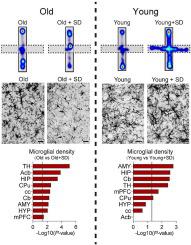Brain, Behavior, and Immunity ( IF 15.1 ) Pub Date : 2023-12-28 , DOI: 10.1016/j.bbi.2023.12.031 Rong-Jun Ni , Yi-Yan Wang , Wen-Jun Pu , Ying-Ying Wei , Jin-Xue Wei , Lian-Sheng Zhao , Xiao-Hong Ma

|
Microglia, resident immune cells in the central nervous system, constantly monitor the state of the surrounding brain activity. The animal model induced by sleep deprivation (SD) is widely used to study the pathophysiological mechanisms of insomnia and bipolar disorder. However, it remains unclear whether SD affects behaviors in young and aged male mice and microglia in various brain regions. In this study, we confirmed brain region-specific changes in microglial density and morphology in the accumbens nucleus (Acb), amygdala (AMY), cerebellum (Cb), corpus callosum (cc), caudate putamen, hippocampus (HIP), hypothalamus (HYP), medial prefrontal cortex (mPFC), and thalamus (TH) of young mice. In addition, the density of microglia in old mice was higher than that in young mice. Compared with young mice, old mice showed a markedly increased microglial size, decreased total length of microglial processes, and decreased maximum length. Importantly, we found that 48-h SD decreased microglial density and morphology in old mice, whereas SD increased microglial density and morphology in most observed brain regions in young mice. SD-induced hyperactivity was observed only in young mice but not in old mice. Moreover, microglial density (HIP, AMY, mPFC, CPu) was significantly positively correlated with behaviors in SD- and vehicle-treated young mice. Contrarily, negative correlations were shown between the microglial density (cc, Cb, TH, HYP, Acb, AMY) and behaviors in vehicle-treated young and old mice. These results suggest that SD dysregulates the homeostatic state of microglia in a region- and age-dependent manner. Microglia may be involved in regulating age-related behavioral responses to SD.
中文翻译:

睡眠剥夺对年轻和老年雄性小鼠大脑区域特定方式的行为和小胶质细胞的不同影响
小胶质细胞是中枢神经系统中的常驻免疫细胞,不断监测周围大脑活动的状态。睡眠剥夺(SD)诱导的动物模型被广泛用于研究失眠和双相情感障碍的病理生理机制。然而,目前尚不清楚 SD 是否会影响年轻和老年雄性小鼠的行为以及各个大脑区域的小胶质细胞。在这项研究中,我们证实了伏隔核(Acb)、杏仁核(AMY)、小脑(Cb)、胼胝体(cc)、尾壳核、海马体(HIP)、下丘脑中小胶质细胞密度和形态的大脑区域特异性变化。 HYP)、年轻小鼠的内侧前额皮质(mPFC)和丘脑(TH)。此外,老年小鼠的小胶质细胞密度高于年轻小鼠。与年轻小鼠相比,老年小鼠的小胶质细胞尺寸明显增加,小胶质细胞突起的总长度减少,最大长度减少。重要的是,我们发现 48 小时 SD 降低了老年小鼠的小胶质细胞密度和形态,而 SD 增加了年轻小鼠大多数观察到的大脑区域的小胶质细胞密度和形态。仅在年轻小鼠中观察到 SD 诱导的多动症,而在年老小鼠中未观察到。此外,小胶质细胞密度(HIP、AMY、mPFC、CPu)与 SD 和媒介物治疗的年轻小鼠的行为显着正相关。相反,小胶质细胞密度(cc、Cb、TH、HYP、Acb、AMY)与媒介物处理的年轻和年老小鼠的行为之间显示出负相关。这些结果表明,SD 以区域和年龄依赖性方式调节小胶质细胞的稳态。小胶质细胞可能参与调节对 SD 的年龄相关行为反应。



























 京公网安备 11010802027423号
京公网安备 11010802027423号